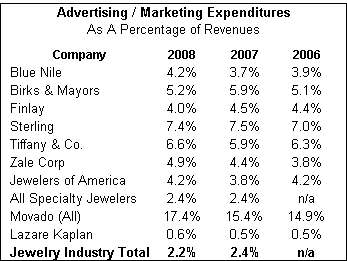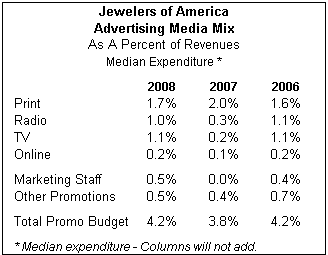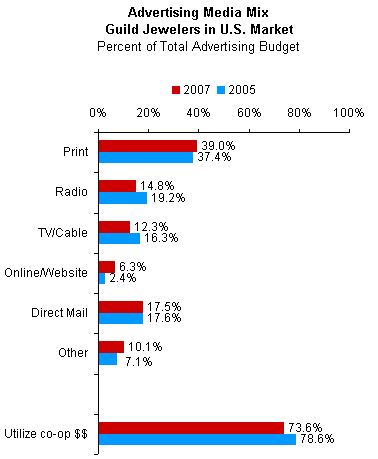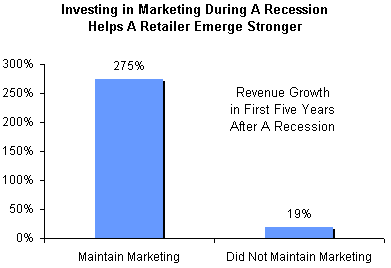IDEX Online Research: How Much Should A Jeweler Spend on Advertising?
November 02, 09
During 2008, specialty jewelers’ advertising expenditure ratio – ad spend as a percentage of revenues – ran at roughly the same level as in 2007: about 2.4 percent of sales. Adweek, which tallies total advertising expenditures by industry, reports that overall specialty jewelers’ ad expenditures were $684 million in 2008. While this was down from 2007’s ad spending of $717 million, it was flat at 2.4 percent of specialty jewelers’ sales.
Another survey – the Jewelers of America Cost of Doing Business – showed that U.S. specialty jewelers who participated in the survey – a more limited sample universe – spent about 4.2 percent of revenues on advertising and marketing in 2008, up from 3.8 percent in the prior year. The Jewelers of America numbers are higher because they include marketing costs in addition to advertising expenditures. Adweek numbers include advertising spend only; unfortunately, some local ad spending – such as ads in high school yearbooks – cannot be reliably tracked by Adweek.
Further, overall industry ad expenditures – including manufacturers ad spend – represented about 2.2 percent of total 2008 jewelry industry revenues of $60.0 billion, according to Adweek, down slightly from the prior year’s 2.4 percent spending level.
How Much Should A Jeweler Spend on Advertising?
Here’s the most important question: “How much should I, as a retail jeweler, be spending on advertising?” We at IDEX Online hear that question all the time. Unfortunately, there is no simple answer. But a new study by IDEX Online Research of jewelers’ advertising expenditures shows that there are some reasonable ranges within the industry.
Highlights of the new study reveal the following:
- Most independent specialty jewelers spend 4-5 percent of revenues on advertising and marketing. Advertising alone represents about half of this amount, while marketing and promotional activities – in-store events, for example – represent the other half.
- Chain jewelers such as Sterling and Zale spend notably more on advertising than independent specialty jewelers – 5 percent to 7 percent of sales.
- Higher-end jewelers tend to spend a greater percentage of their revenues – 6 percent and higher – on advertising and marketing.
- The preferred advertising media is overwhelmingly print for jewelers, followed by (in descending order) direct mail, radio, television, “other” and online.
- A very limited sample shows that manufacturers’ and wholesalers’ co-op advertising dollars could cover as much as 25 percent of a specialty jeweler’s ad budget.
- Typically, luxury goods producers spend up to 20 percent of revenues on advertising and marketing; Movado’s advertising expenditures are in that range. On the other hand, Lazare Kaplan’s direct advertising spend is miniscule – less than 1 percent of corporate revenues.
Jewelry Advertising & Marketing Spend Falls Within Broad Ranges
Most specialty jewelers spend about 4-5 percent of revenues on advertising and marketing. Guild jewelers such as Tiffany & Co. typically spend more, while mass market jewelers tend to spend less.
Further, some chain jewelers such as Sterling have a higher ad spend ratio – ad expenditures as a percentage of revenues – than independent specialty jewelers.
The table below summarizes advertising and marketing expenditures for selected jewelers in the U.S. market.
 Source: Company Reports, Adweek, JA |
There are some key points to be noted, based on the data in this table:
- U.S. GAAP accounting allows some latitude about the classification of “advertising” versus “marketing” expenditures. Some companies use the term interchangeably, while others use a more narrow definition – advertising (only) – as requested by the Securities and Exchange Commission. The data on this table was taken from legal filings.
- Only one company – Birks & Mayors – segments its co-op advertising. On the table above, Birks & Mayors’ ad spend ratio is based on its gross advertising expenditures. Co-op money from vendors reduced its net advertising expenditures by up to 25 percent, depending on the year. Birks & Mayors’ net ad spend ratio – gross spend less co-op dollars – was 3.9 percent in 2008, 4.8 percent in 2007 and 3.9 percent in 2006.
- Movado’s advertising expenditures include ad spend for both its retail and its wholesale operations.
- Lazare Kaplan apparently does very little brand-building advertising on its own. In its legal filings, the company notes that it provides co-op funds to customers, but it does not provide a financial segmentation of those co-op funds. Our sense is that Lazare Kaplan substantially under-spends the average ad spend ratio for luxury goods producers.
- Ad spend ratios for the category “Jewelers of America” are based on ratios calculated in the annual Cost of Doing Business Survey. These are median expenditures, not average spending.
- Ad spend ratios for the category “All Specialty Jewelers” and “Total Jewelry Industry” are based on dollar expenditures supplied by Adweek. IDEX Online Research applied those expenditures against total industry revenues to arrive at the ad spend ratios shown.
Print Is the Preferred Medium for Advertising
Both the American Gem Society (AGS) survey and the Jewelers of America (JA) survey indicate that specialty jewelers in the U.S. market spend about 40 percent of their advertising budget on ads in print media, including newspapers and magazines.
In the other categories, both the AGS survey and the JA survey show that jewelers spend roughly an equal portion of their advertising on television and radio. The JA survey does not ask about direct mail advertising; however, the AGS survey shows that this highly targeted advertising strategy is the second-most popular advertising media for its guild jeweler members.
Most specialty jewelers do not commit a significant portion of their advertising budget to online marketing, according to both the AGS and the JA surveys.
Finally, about three-fourths of AGS jewelers take advantage of co-op advertising allowances from vendors. It surprises IDEX Online Research that some jewelers do not avail themselves of this “free money,” even though there are usually strings attached.
The table below summarizes specialty jewelers’ advertising expenditures, as a percentage of total revenues, by media for the past three years. The table shows a sharp dip in radio and television ad spending in 2007; we believe that is a sampling anomaly and may be related to reporting “median” expenditures rather than “average” expenditures.

Source: Jewelers of America
The graph below summarizes advertising expenditures for guild jewelers – as a percentage of their total ad budget – as reported by the AGS. The AGS does not ask jewelers how much they spend on advertising as a percentage of sales; thus, there is no standard for the ad spend ratio of guild jewelers. However, based on ad spend ratios for Tiffany and Birks & Mayors, both guild jewelers, we conclude that higher-end jewelers tend to commit more of their revenues to advertising and brand-building.
 Source: AGS |
Between 2005 and 2007, AGS jewelers shifted away from using electronic media and increased their advertising expenditures for online and print media.
How Much Should You Spend?
As the old saying goes, “if we had a nickel for every time we’ve been asked that question, we’d be rich!” The answer: it depends.
We went to the internet to see if we could get some free guidance. Most of the results we got were ads for advertising agencies which offered documents disguised as a “white paper” or some other seemingly scholarly tome. Those documents were not helpful. There are, however, a few sources – Adweek and Advertising Age, for example – which offer ad spend ratios by industry, but they want a significant fee for the information.
In general, here’s what we found, based on legal filings with the SEC:
- Discount merchants tend to spend 2-3 percent of revenues on advertising. Wal-Mart spends only 0.6 percent on advertising. But with over $400 billion in revenues, that level of advertising expenditure goes a long way.
- Specialty retailers tend to spend around 4 percent of revenues on advertising. This is at the low end of the range for jewelers. However, it confirms that the jewelry industry average of 4-5 percent is probably reasonable.
- Department stores – those heavy newspaper advertisers – spend 5 percent or so of their revenues on advertising.
- Luxury goods producers spend up to 20 percent of their revenues on brand-building and advertising.
In a recent presentation, Whitney Sielaff, publisher of National Jeweler, showed a slide which illustrated the importance of maintaining advertising and marketing efforts during a recession. Sielaff explained that, based on research in the 1980s recessions, merchants who maintained aggressive sales and marketing efforts enjoyed dramatically greater growth after the recession than those merchants who cut their advertising.
Of those companies who maintained aggressive marketing efforts despite the recession, their revenues grew by 275 percent in the five years post-recession. In stark contrast, those merchants who cut sales and marketing efforts during a recession posted sales growth of only 19 percent in the five years following the recession.
The graph below illustrates the point that Sielaff made:

Source: Nielsen
If we were a specialty jeweler, we’d take the advice of Bruce Freshley, whose Freshley Media serves the jewelry industry. In one of his recent newsletters, he quoted Henry Ford as saying: “A man who stops advertising to save money is like a man who stops a clock to save time.” It won’t work.